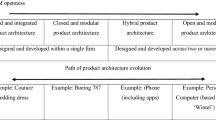Abstract
An empirical study of the relationship between product architecture and industry structure is discussed. Product architecture is modeled by using Design Structure Matrices (DSMs) representing three different types of intercomponent relationships: technological homogeneity, functional interaction and assembly process contiguity. The DSM models may be used to explain firms’ specialization choices within an industry. Moreover, the same models can provide a rough-cut forecast of the impact that modular and architectural innovation may have on industry structure. The method is then applied to the automotive industry, using empirical data on automotive suppliers located in the province of Turin, in Northwestern Italy.
Access this chapter
Tax calculation will be finalised at checkout
Purchases are for personal use only
Preview
Unable to display preview. Download preview PDF.
Similar content being viewed by others
25.6 References
Andersson, S., Nilsson, P., Malmqvist, J., 2003, “Exploring Requirements Management in the Automotive Industry,” Proceedings of ICED’03, Stockholm, Sweden.
Camuffo, A., 2001, “Rolling Out a ‘World Car’: Globalization, Outsourcing and Modularity in the Auto Industry,” Working Paper, IMVP (International Motor Vehicle Program), available at: http://imvp.mit.edu/papers/0001/camuffo1.pdf
Cantamessa, M., Rafele, C., 2002, “Modular products and product modularità — implications for new product development,” Proc. DESIGN2002, 7thInt. Design Conference, May 14–17, 2002, Dubrovnik.
Cebon P., Hauptman O., Shenkar C., 2001, Industries in the Making: Product Modularity, Technological Innovation and the Product Lifecycle, Melbourne Business School.
Henderson R., Clark K.B., 1990, “Architectural innovation: the reconfiguration of existing product technologies and the failure of established firms,” In: Administrative Science Quarterly, No. 35, pp. 9–30.
Jackson, D.A., 1995, “PROTEST: a PROcrustean randomization TEST of community environment concordance,” In: “Ecoscience”, Vol. 2, pp. 297–303.
Kruskal J.B., Wish M., 1978, Multidimensional Scaling, Sage Publications, Beverly Hills, CA.
Mantel, N., 1967, “The detection of disease clustering and a generalized regression approach,” In: “Cancer Research”, No. 27, pp. 209–220.
Novak S., and Eppinger, S.D., 2001, “Sourcing by design: product complexity and the supply chain,” Management Science, Vol. 47, No.1, pp. 189–204.
Pimmler T.U., Eppinger, S.D., 1994, “Integration Analysis of Product Decompositions,” Proc. ASME Design Theory and Methodology Conference, September 1994, Minneapolis, MN.
Sanchez R., Mahoney J.T., 1996, “Modularity, Flexibility, and Knowledge Management in Product and Organization Design,” Strategic Management Journal, Vol. 17, Winter Special Issue, pp. 63–76.
STEP Economics, 2003, “La mappatura della filiera autoveicolare in Piemonte”, final report of the “Dall’Idea all’Auto” project (in Italian).
Steward D., 1981, “The Design Structure Matrix: a Method for Managing the Design of Complex Systems,” In: “IEEE Transactions on Engineering Management,” Vol. 78, pp. 71–74.
Ulrich, K., 1995, “The Role of Product Architecture in the Manufacturing Firm,” In: “Research Policy”, Vol. 24, pp. 419–440.
Author information
Authors and Affiliations
Editor information
Editors and Affiliations
Rights and permissions
Copyright information
© 2006 Springer-Verlag London Limited
About this chapter
Cite this chapter
Cantamessa, M., Milanesio, M., Operti, E. (2006). Value Chain Structure and Correlation Between Design Structure Matrices. In: ElMaraghy, H.A., ElMaraghy, W.H. (eds) Advances in Design. Springer Series in Advanced Manufacturing. Springer, London. https://doi.org/10.1007/1-84628-210-1_25
Download citation
DOI: https://doi.org/10.1007/1-84628-210-1_25
Publisher Name: Springer, London
Print ISBN: 978-1-84628-004-7
Online ISBN: 978-1-84628-210-2
eBook Packages: EngineeringEngineering (R0)




